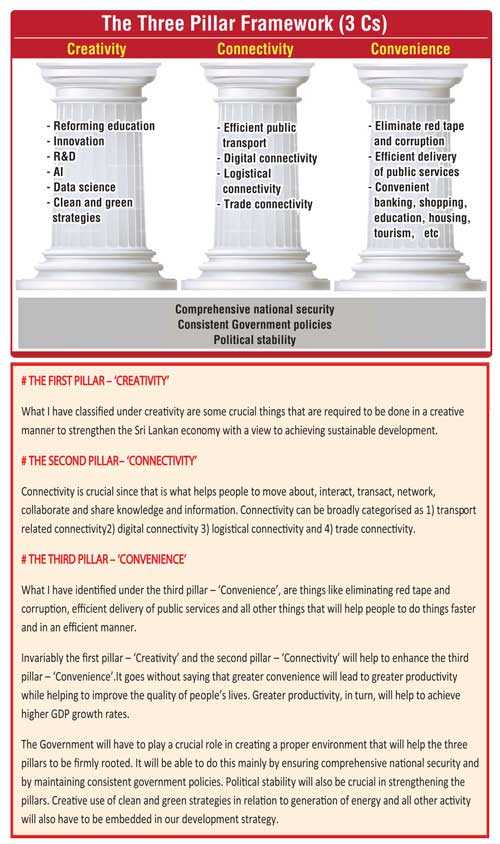Thursday Apr 25, 2024
Thursday Apr 25, 2024
Tuesday, 6 August 2019 01:40 - - {{hitsCtrl.values.hits}}
Continued from yesterday
The second pillar – ‘Connectivity’
Connectivity can be categorised in many ways such as transport related connectivity, logistical connectivity, trade connectivity and all efficient forms of networking and communication including digital connectivity.
Efficient public transport helps people to move about faster, thereby saving them time and money. Therefore, efficient public transport helps to improve the productivity of people.
Efficient digital connectivity through improved telecommunications, ICT, the internet and social media are crucial for the advancement of science, business and commerce as well as to share ideas. The synergies brought about through these means are crucial for sustaining and supporting the first pillar, i.e. ‘Creativity’, and also the third pillar, i.e. ‘Convenience’.
Connectivity is crucial since that is what helps people to move about, interact, transact and share knowledge and information. Working in silos is not going to take the country forward.Both intra industry connectivity and inter-industry connectivity are required to take the economy forward. Enhanced connectivity and the related multidisciplinary approach are required to unleash the true springs of economic growth.

Information sharing through better connectivity and networking
Information sharing through better connectivity and networking is crucial in taking the country forward in the spheres of business, economics and national security, etc. In relation to national security, it is pertinent to refer to a recent lecture made by the former US Ambassador to Sri Lanka Robert O. Blake at the BMICH (7 May 2019).
During the course of his lecture, Blake had recommended the establishment of a high-level group of technocratsensuring that different branches of the intelligence shared information and then shared that information up to the senior level people, so that they in turn could make sure that somebody was looking into those concerns and making sure that the terror attacks won’t take place. It is through such connectivity and sharing of information within a framework of clearly defined goals and objectives that the desired results can be achieved. This type of connectivity and networking is required to achieve the desired results not only in relation to national security but also in relation to other spheres such as science and technology, business and commerce, and economics.
According to an article in the Harvard Business Review, the most effective innovators do not make the entire decision by themselves. Rather, they gather ideas from everyone in their organisation, to draw on a centralised architecture, in order to get the most out of their efforts.
By way of an example, the CEO of the Bosch group, VolkmarDenner invited the entire workforce of the company to help him come up with a new business model for the company. He ended up receiving about 1,800 ideas in six days. Once an idea was selected from this pile, team members were brought in from around the world to help build up on the project. Their final project ended up being “community based parking”, which is a system which makes use of the car’s sensors in order to detect empty parking spaces. Information collected from a network of cars is uploaded onto a cloud, which can then help in creating an up-to-date map of all the free parking spots in the area. (What sets the most effective innovators apart, Harvard Business Review, 8tMarch 2019).
This kind of collaboration and networking is also backed up by another article that appeared in the Daily FT, which stated that leaders should always go to lunch with their team, and encourage views from everyone (even if these views may counteract their own), so that a more informed decision could be made. The idea of everyone coming together to build one project is nicely termed a “co-creation” in this article. (Seven big ideas for leaders in 2018: Reflections from the 9th Global Peter Drucker Forum, Daily FT, 26 January 2018).
Transport, logistics, and trade related connectivity
The next section explores the efforts taken by Singapore to improve connectivity in the spheres of transport and trade, and thereby propel the Singaporean economy to greater heights.
The Singaporean Government has made significant investments with a view to making Singapore a transport hub in Asia. In 2015, the aviation sector accounted for 3% of Singapore’s GDP and employed over 50,000 people. Further, the Port of Singapore is essential to maritime trade, and the government is currently investing to transform Tuas into a major sea port. This port will be equipped with the latest technology, such as big data analytics and smart computing.The Port has worked closely with shipping lines to help build one of the world’s most dense maritime networks. Upon completion of the Next Generation Port in 2040, the Singapore Port will be able to process the equivalent of 65 million standard shipping containers, making it the largest integrated facility in the world.
Singapore also has an extensive network of Free Trade Agreements with more than 30 trading partners enabling it to gain access to the major markets of the world. This facilitates many logistics chains to easily operate from Singapore.As many as twenty of the world’s top 25 logistics firms manage their global and regional operations from Singapore. 
Having this many major international players in the country will mean that domestic firms will now have to benchmark against international standards, encouraging creativity and innovation.
Extensive consultation with the private sector is encouraged by the Singaporean government before a public investment is made, to make sure that investments are only made on things that will actually have a very good impact on Singapore’s economy. Furthermore, the Government encourages the private sector to invest in complementary infrastructure, e.g. private sector operators such as FedEx have invested in air cargo facilities such as the cold chain centres and regional express cargo facilities, with the Government helping to build the business case for such investments. Challenges are resolved together, so that the investment would make commercial sense to the private sector.
In addition to the above, the major infrastructure projects on public transport that will unfold over the next 10 years, will greatly improve connectivity within Singapore. (Three factors that have made Singapore a global logistics hub, World Bank Blogs, 26January 2017; Refreshing Singapore’s Infrastructure for Future Generations, Singapore Government Budget 2018).
The next section deals with digital connectivity and cites Canada as an example.
Digital connectivity
In Canada 5G connections are expected to be rolled out by 2026, according to a report commissioned by the Canadian Wireless Telecommunications Association (CWTA), and these new networks are expected to create more than 250,000 permanent jobs and contribute an estimated $ 40 b annually to Canada’s economy over the next few years. 5G will eventually become the backbone to smart cities and self-driving vehicles, and its benefits will extend well beyond consumer applications. These 5G networks will fuel Canadian innovation across industries, with new applications and emerging technologies (such as the Internet of Things (IoT), augmented and virtual reality, digital healthcare and robotics) vastly improving productivity and boosting efficiencies. (How 5G connectivity will keep Canada competitive, Financial Post, 10 January 2019).
The third pillar
– ‘Convenience’
The concept of convenience is fundamental to improving the quality of life. People are constantly on the lookout to see how they can get things done more conveniently because all of us value time and do not want to waste time. Therefore, people constantly seek convenient housing, convenient transport, convenient education (such as online education), convenient shopping, convenient banking, convenient tourism, and so on and so forth. Thus we can see that people look for convenience in relation to almost anything.
What I have identified under the third pillar – ‘Convenience’, are things like eliminating red tape and corruption, and all other things that will help people to do things faster and in an efficient manner. Therefore, invariably the first pillar - ‘Creativity’, and the second pillar - ‘Connectivity’ will help to enhance the third pillar - ‘Convenience’.It goes without saying that greater convenience will lead to greater productivity. Greater productivity, in turn, will help to achieve higher GDP growth rates.
Better accessibility to government agencies, and effective and efficient delivery of public services are also important elements in improving the convenience afforded to people, and this in turn helps to increase the productivity of people.Improving the ease of doing business is also important since that will go a long way in encouraging more investments including foreign direct investments.
Various mobile apps have gone a long way in improving the convenience afforded to people.Online grocery shopping apps that enable delivery right to your doorstep could also save a whole lot of time, especially for the elderly community, who find it difficult to physically go to a grocery store, and spend time picking vegetables and fruits and waiting in ques. (MGI research highlights technology’s role in improving societal well-being and smoothing disruption).
By way of another example in relation to making life convenient for people, some of the latest Amazon stores around the world have this concept named “Just walk out”, where you walk into the store, and the store keeps track of what you pick up, and what you’re buying/not buying. There is no checkout counter, and you just have to scan your phone to pay. This example nicely shows how convenience and creativity can combine to help save time and effort of the average consumer in the country.(Sri Lanka must increase focus on technology and innovation as drivers of economy, Daily FT, 20 June 2018)
Increasing the efficiency of public transport will help to increase the productivity of people by saving time that they have to spend on the roads. By way of an example, due to the work put in by the Singaporean government to improve public transport, eight in 10 households will be able get to a railway station within a 10 minute walk. (Refreshing Singapore’s infrastructure for future generations, Singapore Government Budget 2018).
The above examples show how things can be made more convenient for people, enabling them to channel more time to engage in productive endeavours.
Conclusion
The three ‘C’ framework proposed by the writer and explained above provides a guide for a country which is serious about sustainable development. It is only through such a holistic approach that a country could achieve sustainable development.
All the developed countries in the world have got the three ‘C’s right. Those countries have diligently pursued such a strategy over a considerable period of time. It is important for Sri Lanka too to pursue such a strategy, diligently and consistently. That is the only way in which the country could achieve sustainable development.
[The writer counts over two-and-a-half decades of experience in the field of economic research in the private sector. He has earned a BA (Hons) in Economics, an MA in Economics and a PhD in Economics at the Department of Economics of the University of Colombo. He can be reached at [email protected].]